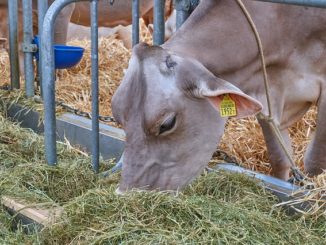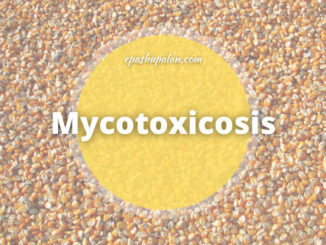Abstract
Minerals are important nutritional components constituting only 5% of the bodyweight of the animals, having a major role in the health, production, reproduction, and immune defense of the animals. Minerals are classified into macro and micro minerals according to their quantitative requirement. Major macrominerals of structural and functional importance are calcium (Ca), phosphorous (P), magnesium (Mg), sulphur (S), sodium (Na), potassium (K), and chlorine (Cl). Macrominerals are major components buffer systems, body fluids, osmotic pressure, and electric potential across cell membranes and nerves. Trace minerals or microminerals in the animal body are cobalt (Co), copper (Cu), zinc (Zn), iodine (I), iron (Fe), manganese (Mn), selenium (Se), molybdenum (Mo), and chromium (Cr). They are components of various hormones, enzymes, and cofactors. Different minerals perform various structural, functional, and regulatory functions in the animal body and the requirements are met usually by supplements. Dairy animals are the culprits of mineral deficiency because of their high production requirements and non-availability of quality feed. So, they are unable to meet their enhanced mineral requirements and ultimately they end up with poor production and reproductive performance. Let us discuss various macromineral deficiencies prevalent in livestock and their amelioration strategies.
Keywords: minerals, macrominerals, health, production, reproduction
Calcium (Ca)
Calcium is the major structural constituent of skeletal, dental system and is involved in muscle contraction, and neuromuscular excitability. Serum/Plasma Calcium is an indicator of the Ca status of the animal body and it is of diagnostic value. The normal value of serum Ca in bovines is 9-10 mg/dl. The requirement of Ca varies as per the age and physiological status of the animal, especially during the different stages of pregnancy. Ca deficiency in young animals is associated with failure of bone mineralization and leads to a clinical condition called “rickets”. While in older animals, to maintain sufficient plasma Ca level, Ca resorption takes place from the bones leading to osteomalacia and osteoporosis. In this clinical condition demineralization of bones lead to sudden fractures. High yielding dairy cows, excess Ca lost through milk lead to parturient paresis or milk fever which can be fatal if timely treatment is not given.
Clinical signs
Clinical symptoms are divided into 3 stages. The first stage is characterized by excitement and tetany, the second stage by sternal recumbency with lateral kinking of the neck, and the third stage by lateral recumbency and complete flaccidity. Anuria and weak heart sounds are predominant at the third stage leading to cardio-respiratory failure. Usually, hypocalcemia is accompanied by Mg or P deficiencies. In the case of hypomagnesemia, excitement signs are present.
Treatment
Treatment should be initiated immediately for a good prognosis. Delayed treatment will lead to complications like downer cow syndrome and the prognosis tend to be grave. The treatment should be initiated with replacement therapy, where parenteral injection of Calcium is carried out @1g/kg body weight. Injectable Calcium borogluconate (20% or 33%) solution is administered slow intra venously with continuous monitoring of the heart through auscultation because of its cardiotoxic nature. The half of the dose should be administered subcutaneously or intraperitoneally to ensure continuous blood level of Calcium. Calcium Magnesium borogluconate can also be given @ 200 to 350 ml i.v. The signs of positive responses to therapy are tremor, rumination, muzzle sweating, urination, defecation etc. The animal stands up from recumbency if the requirement of Ca is met by therapy.
Prevention and control
To prevent milkfever, dietary Calcium during gestation should not be increased by more than 100g/day. Ten days before calving, daily dietary calcium should be <20g to maintain proper Ca homeostasis. The ideal Ca:P for prevention of milk fever, i.e 1:3.3. Ensure proper Anion-Cation balance by the inclusion of Chloride and Sulphur (Anions) in the diet. Vit D3 supplementation 1 week before calving @10 million units. Oral Calcium gel (Before calving, at calving, 12 hours, and 24 hours post-calving) should be administered.
Phosphorous (P)
Phosphorous deficiency/post-parturient hemoglobinuria is the most prevalent mineral deficiency in bovines across the globe. The major etiology for P deficiency is poor P content of forages, especially mature forages. Around 80% of total body P reserve is present in bones and teeth. It is the main component of cellular energy transactions and buffer systems of the body. They are the structural component of phospholipids, phosphoproteins, and nucleic acids. The normal plasma concentration of P in cattle ranges from 4-8 mg/dl. In ruminants, P is required by the ruminal microbes for the digestion of cellulose as well as for the synthesis of microbial proteins.
Clinical signs
The clinical signs associated with hypophosphatemia are anorexia, dullness, depression, depraved appetite, weakness, hemoglobinuria, cessation of rumination, respiratory distress, constipation, and sometimes gangrene of extremities. Death follows after the onset of anemic anoxia.
Treatment
Immediate correction of anemia is life-saving. Specific therapy involves P supplementation as Sodium acid phosphate- 80g dissolved in 400ml Distilled water as slow i.v., Bone meal or Dicalcium phosphate (120g) orally twice daily for 5 days or Inj. Tonophosphan @10-15ml i.m per day for 5 days
Prevention
The maintenance requirement of Phosphorus @20g/day and additional requirement is 0.8g/500g of milk produced. Daily supplementation of Dicalcium phosphate orally @100g is preventive. Avoid feeding kale, beets, turnips, and alfa-alfa while grazing in the pasture.
Magnesium (Mg)
Magnesium is a co-factor of certain enzymes like thiamine pyrophosphate, creatine kinase, pyruvic acid carboxylase, etc. The normal magnesium level is 2.3 mg/dl of blood. About 70% of the total Mg is stored in bones and soft tissues. The requirement of Magnesium is 0.20% of the total dry matter for lactating cows and 0.12% for pregnant cows. Young lush pasture is often deficient in Mg and it is one of the major etiology. High Potassium in pasture inhibits Mg uptake by plants and thereby animals’. Mg deficiency leads to the secretion of acetylcholine esterase and tetanic signs.
Clinical signs
Acute tetany is characterized by muscle twitching, nystagmus, frothing from the mouth, champing of jaws, and sudden death. Subacute tetany is gradual in onset, head throwing, spasmodic urination, and frequent defecation and responds to treatment. Chronic tetany is mild in symptoms like dullness and unthriftiness. If parturient paresis is coupled with hypomagnesemia, hyperaesthesia and tetany will be present instead of flaccidity.
Treatment
The best treatment is the parenteral administration of a solution containing Ca and Mg salts. Intravenous Mifex @1 bottle or Magnesium sulfate (10-20% solution) @200-300ml s.c. or Magnesium gluconate (15% solution) @200-300 ml s.c. Mg can be administered as an oral drench or enema.
Prevention
As a preventive measure, Mg can be supplemented in drinking water daily. 5-10kg Magnesium sulfate may be added to 200L drinking water. Mg releasing intra-ruminal bolus, and minimizing stress are other measures.
Potassium (K)
Potassium is the major component of intracellular fluid and it is responsible for the maintenance of acid-base balance and osmotic pressure. The other functions are conduction of nerve impulse, muscle contractions and cell membrane functions. Potassium deficiency is the secondary product of anorexia, diarrhea, abomasal torsion and displacement. Another etiology is rapid growth of animals and treatment of ketosis in ruminants with isoflupredone acetate.
Clinical signs
Major clinical signs are a rapid drop in milk production, muscle weakness, paralysis, and cardiac arrhythmias. Kidney functions are affected and the inability to concentrate urine is evident. Gastric secretions and intestinal motility are altered. Minor symptoms are nervousness and agitation.
Treatment and control
Treatment included i.v and oral administration of potassium chloride and fluid therapy.
Sodium and Chlorine (Na and Cl)
The major etiology for Na and Cl deficiency is the loss of Na in milk and sweat. Additional reasons are low sodium intake and overuse of Potassium containing fertilizers in the soil. Usually, high-producing animals are affected. Other than plasm a sodium, urinary or salivary Sodium also give indication of Sodium status. In Sodium deficiency, serum sodium is <137mmol/L.
Clinical signs
The initial sign of Sodium and Chlorine deficiency in ruminants is a craving for salt. Chronic deficiency leads to poor growth, inappetence, unthriftiness, reduced milk production, and loss of weight. These signs can lead to sudden collapse.
Treatment and prevention
Salt block licks can be provided to dairy animals but care must be taken to avoid toxicity by overfeeding.
Sulphur (S)
Sulphur is necessary component of S-containing aminoacids. Another major functions are the synthesis of vitamins and coenzymes in the rumen. Sulphur deficiency leads to decreased rumen fermentation of cellulose and organic matter as well as a decline in microbial protein mass in the intestine. The Daily S requirement could be met with 0.2% S in the diet. Tropical grasses are deficient in Sulphur and therefore S deficiency is common in the tropics.
Clinical signs
Major deficiency signs are associated with protein deficiency namely poor growth, loss of weight, lacrimation, drop in milk production, emaciation, weakness, and death.
Treatment and control
Sulphur should be supplemented @1.5g/ kg DM provided the N:S ratio maintained at 10:1.
Conclusion
We discussed common micromineral deficiencies in farm animals and their diagnosis by clinical signs and laboratory estimation. Their amelioration by adoption of appropriate treatment measures and preventive measures have also been discussed. The micromineral deficiencies are leading to greater economic losses to the farmers as most of them are directly or indirectly impacting their productivity. So, the earlier they are diagnosed, the treatment could be attempted and greater losses could be avoided. Farmers should focus on preventive measures by proper supplementation of minerals at appropriate doses.
| The content of the articles are accurate and true to the best of the author’s knowledge. It is not meant to substitute for diagnosis, prognosis, treatment, prescription, or formal and individualized advice from a veterinary medical professional. Animals exhibiting signs and symptoms of distress should be seen by a veterinarian immediately. |






Be the first to comment